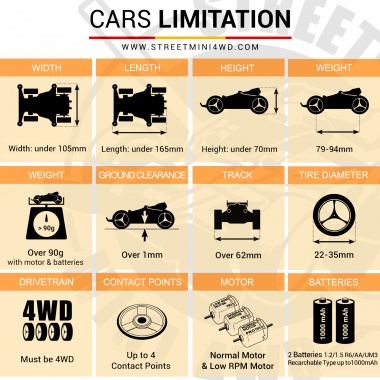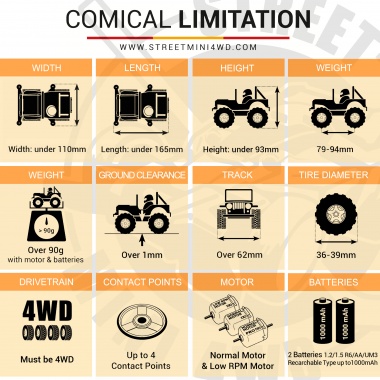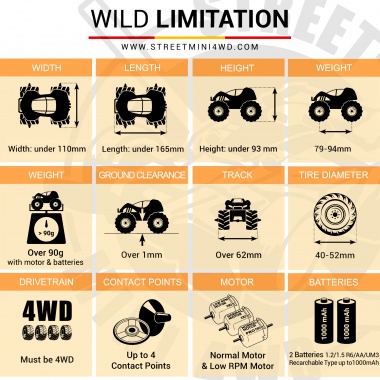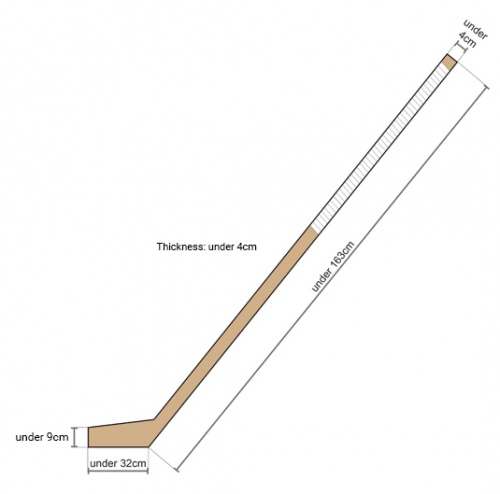Competition Rules
Versione 12 (06-12-2023)
- Orange:modified articles
- Green: added articles;
Indice
- 1 Vehicles type
- 2 Race Car Features
- 3 Cars limitations
- 4 Motors
- 5 Power source
- 6 Optional and spare parts
- 7 Modifications
- 8 Body
- 9 Cars inspection
- 10 Guide stick
- 11 Racer
- 12 In-race behavior
- 13 Management of races and penalties
- 14 Penalties
- 15 Sanctions and decisions of race Officials
- 16 Disqualifications
- 17 Restrictions and repeal
- 18 Responsibility
- 19 Sommario
Vehicles type
1. Either any mini 4WD models are allowed as long as they comply with the measures and the other articles of this regulation.
Race Car Features
1) With the term "Car / Machine" this regulation identifies the inseparable union between body and chassis of a mini 4WD. Changing one of these two parts during a Street Mini 4WD event is equivalent to replacing one's car with another car (spare car);
2. The car must have a functional 4WD system, which must not have any modifications to change its core function;
3. During the races, cars should not be a danger or hinder opponents cars in any way;
4. All cars must be inspected by the competition Officials. All components must comply with the regulation. Cars that have not passed the inspection may not take part in the competitions;
5. It is allowed to own a spare car. Whenever the spare machine will be needed, the competition Officials will inspect it. The main car cannot be replaced with the spare car during its run;
6. It is forbidden to use any gimmicks that change the core essence of a four-wheel drive race car. For example, the use of crawlers instead of tires is not allowed. The Officials will evaluate, case by case, every questionable solution used in a car.
Cars limitations
1. Maximum width (included rollers, extensions, etc.…): 105mm;
2. Maximum height (included spoilers, stabilizers, etc.…): 70mm;
3. Maximum length (included anti rollover, reinforcements, etc.…): 165mm;
4. Minimum height from the ground: 1mm;
5. Minimum weight of the car ready to run: 90gr;
6. Tires diameter: MIN. 22mm MAX. 35mm;
8. Minimum wheel track: 62mm;
9) Maximum number of contact points on dimension checker walls (eg. guide rollers): 4;;
- Double “hourglass” rollers count as 1 support;
Comical mini 4WD
For this category of racing cars the same rules apply as the canonical mini 4WDs reported in this regulation. The inclusion of this category will depend on the stretch of the race, the race and / or the event in progress. The range of measures that characterizes this category is the following:
1) Maximum width (included rollers, extensions, etc.…): 110mm;
2) Maximum height (included spoilers, stabilizers, etc.…): 93mm;
3) Tires diameter: MIN. 36mm MAX. 39mm;
Wild mini 4WD
For this category of racing cars the same rules apply as the canonical mini 4WDs reported in this regulation.
The inclusion of this category will depend on the stretch of the race, the race and / or the event in progress.
The range of measures that characterizes this category is the following:
1) Maximum width (included rollers, extensions, etc.…): 110mm;
2) Maximum height (included spoilers, stabilizers, etc.…): 93mm;
3) Tires diameter: MIN. 40mm MAX. 52mm;
Motors
1. Only 130 class Normal/Stock* motor or Low RPM (item 75028) distribuited by Tamiya mini 4WD are allowed; Motors included in the mini 4WD / RC (black cap), Touch Dash or Atomic Tuned are not allowed even if present inside the assembly box.
*which is found into a Tamiya mini 4WD assembly box or selled (eg. 94380)
2. The motor cannot be changed after the inspections. However, it is possible to have more motors inspected, in order to choose freely which one to use;
3. The motors cannot be modified either externally or internally;
4. The only modifications allowed on motors are tuning, i.e. break-in and their maintenance (use of cleaners and lubricants);
5. Modifying the position of the rotor with respect to the motor cover is forbidden. For example, the use of ball bearings or any other spacers;
6. The race officials will mark the motors passed upon inspections;
Power source
1. You can mount on your car only two AA batteries from 1.2/1.5 volts R6/AA/UM3 recently sold by Tamiya or compatible types (see article 2);
2. Maximum Amperage allowed for a single rechargeable battery: 1000mAh (Ni-Mh);
3. Battery alterations are not allowed;
4. Batteries must have their specifications clearly visible on them;
5. Some events may impose different rules regarding the type of battery or its brand;
Optional and spare parts
1. Any spare part can be used, it can be hand-built and/or manufacted from any brand as long as they do not transgress the other articles of the Regulation.
2. Tune up parts can be modified without violating the Regulation;
Modifications
Please pay attention to the modifications you make on your car.
1. The body and the chassis can be modified to be lighter;
2. The gears can be modified for any reason, particularly to increase or decrease the ratio. In some races a ratio limitation may still occur;
3. The tires and wheels can be modified without violating the Regulation;
4. It is possible to always use any kind of electronic devices as long as they are powered by the same power source of the car, and provided they do not violate the Regulation. It's allowed the use of Tamiya Mini 4WD items designed with auxiliary power supply such as 15033. Auxiliary power sources are allowed ONLY for lighting systems (LED);
5. It is possible to use self-built parts that do not violate other articles of the Regulation;
6. It is not allowed to modify the chassis and parts of it to expose the gears;
Body
1. During the races, cars should always be distinguishable and identifiable;
2. The body can be modified at will of the racer, but modifications must be realistic and not in conflict with other articles of the Regulation. Among the unrealistic modifications are the following examples:
- The body can be lightened, but weight reduction must not lead to the transformation of the body in a "plastic strip" that goes from the front bumper up to the rear closure;
- The body must not have excessive round holes that reduce it to a "sieve";
3. Transparent bodies must be colored in order to be distinguishable;
4. Car bodies must cover part of the batteries, and must have a minimum length given by the distance between the front and rear shaft;
5) The body must be properly secured to the chassis, in order to prevent the body from unhooking during a race. More specifically, the body must have at least two attachment points, and it must be clamped firmly to the chassis;
Cars inspection
1. All cars must be inspected by the race Officials;
2. During races, cars and the route parts can be inspected at any time. In cases of irregularity, the result of one or more different races may change, even if these races are already being concluded;
3. The car's set-up cannot be changed after each inspection, unless it is specifically allowed;
4. The Officials checks may be any time and they include:
- Control of the technical requirements of the car;
- Checks upon measurement limits;
- Height from the ground control, made on flat surface long the whole car;
- Verification of the mechanical;
- Motor verification;
- Checking for the match of the batteries with those permitted;
- Verification of the presence of non-allowed modifications;
Guide stick
Characteristics
1. The stick can be of any weight, size and material;
2. The stick can be decorated, lightened, and modified as long as it does not violate any Article of the Regulation;
3. The stick must not have any kind of fixed contacts with the car (wires, cables, cords, etc ...);
4. In ambiguous situations like unusual materials or functions, these characteristics must be approved by the Officials;
5. The guide stick must have beveled edges and any projection removed;
6. Non-fluorescent tape of any color can be wrapped around the stick at any spot;
Restrictions
1. Handle maximum lenght : 163 cm end to end;
2. Handle maximum width : 4 cm;
3. Handle maximum thickness : 4 cm;
4. Blade maximum lenght : 32 cm end to end;
5. Blade maximum width: 9 cm;
Use of the guide stick
1. The stick can be used both to control the car during its travel and as a part of route. For example, the blade can be used, by tilting the stick, as small ramp to help the machine overcome a very high hurdle;
2. The stick must not be used to intentionally harm the racers or the opponent cars;
3. The stick must not be used to push or press the car into the ground, although it can be used to put back an overturned race car, blocked by an obstacle and similar;
4. It is not allowed to use the guide stick as a tool to lift the car off the ground and overcome route sections;
5. It is not allowed to violently hit the car with the guide stick to overcome obstacles or make the car faster, but it’s permitted for safety measures (save the car by any serious accident);
Racer
1) Each racer must not use equipment or wear anything that is dangerous for others and for himself;
2) It is mandatory to use running shoes;
3) Tools to facilitate running such as skates and the like are prohibited;
4) During the race, the racers must never have intentional physical contact with each other in order not to compromise the safety of the participants (each situation will have to evaluate, case by case, the race judges);
In-race behavior
1. During a race, it is not allowed to pick up your own or opponents’ car, and shorten or lengthen route parts;
2. It is not permitted to control the car during a race by other means than the use of the guide stick (unless exceptions provided in some races);
3. The racer must not have fixed contact with his machine;
4. During a race, the racers can stop and pick up one or more parts of their car, or their driving stick, if accidentally detached;
5. During a race, it is forbidden to exchange or lend cars to other racers. If there are doubts that a competitor is racing with a car designed and built by others, it might be required to disassemble and reassemble the car or to describe some characteristics, in order to prove that he is the actual owner of the car;
6. It is mandatory to show up on time, when called for the race. Otherwise, the racer will be excluded from the race;
7. During a race with a predetermined route, it is forbidden to “cut” part of the track to get first to the finish line. In case the racer was to make a mistake, he must reach the point at which he began to miss the path, and from that position, resume the normal race;
8. It is allowed to touch your machine with hands to put it back into the race if it is impossible to move forward, for example when it goes to flip or malfunction;
9. For each race, there will be established a time limit for which that competition must be ended within. A race ended exceeding the time limit will not be considered valid, therefore the Officials will decree the outcome of it;
10) It is not possible to change the chassis and / or body when setting up your car as these two components represent a single entity: the racer's car. The change of these two parts involves the replacement of the first car owner with the spare car;
11) A racer can stop the starting procedure before the word "GO!" is pronounced for any problem that has occurred. If the problem is resolvable immediately, the problem is expected to be solved (max 5 minutes). The racer can repair his car in this time or decide to switch to his spare car. If the problems persist during the start the opponent will win the race. In the event that problems arise after the start of the race, it will be the racer's responsibility to resolve the situation without interrupting the race;
12) During a race, only racers running in that race and the race judges can move within the track. No intervention by racers outside the race is allowed: it is not possible to follow another racer during the race or to give him spare parts or a guide stick;
13) In team races, the racers who are running a race (not the external teammates), can substitute a teammate in case they have difficulty. It is not allowed to exchange cars but, in the event that a racer's guide stick is irreparably damaged, it is possible for the other racers of the team in the race at that time to lend their guide stick.
Races on track
A well-designed Street mini 4WD should be able to run on many grounds and overcome different situations. It is possible that cars can participate in races and / or traits of the race in a traditional track.
1. In competitions on track, no racer must touch / move the track without the Officials’ agreement;
2. In races on track, cars must not damage the bottom, sides and other parts of the track;
3. In races on track, it is forbidden to interfere in any way during the march of the machines, unless it is specifically allowed;
Management of races and penalties
1)Each racer or team will be followed by video by a race manager who will take care of filming the entire race of that team;
2. Each race provides that a race judge gives the go-ahead to the racers in the race. After the first team arrives at the finish line, another race judge will start a timer that will indicate the distance in seconds between the first finisher and the second finisher.
3. At the end of the race, the video footage of that race will be viewed by the race judges currently active. The judges may impose one or more time penalties in the event of anomalous situations visible from the video footage.
4) Repetition of a race: in the case of dedicated referees, if a dispute arises about an alleged incorrectness, the match videos are viewed. If the video footage has not been done correctly, the race will be repeated.
Management of matches and penalties in the absence of dedicated referees
1) In the event that there are not enough external figures to the participants of the event to assume the identity of race judges and race managers, further regulations are necessary.
2) Team case: each team will offer members of their team who will take care of filming the race in progress (race managers). Those filming must not belong to one of the two teams competing at the time;
3) Team case: Like the race officials, the race judges will also be chosen from among the teams (in rotation);
4) Team case: The referees must not belong to a team currently in the race;
5) In the event that a dispute is made about a runner and the race manager coming from a team has incorrectly resumed the progress of the runner assigned to him involved in the dispute (for example by resuming in a completely different direction), the penalty it will be assigned to the team to which the match manager belongs.
The penalty will be assigned to the team that possibly has incorrectly restarted a race or has not restarted the race.
Penalties
Any penalties of the first classified team in the race provide for a subtraction of TOT * seconds on the time between the arrival of the first classified team and the second. If this time goes negative, the second ranked team will win, vice versa the first ranked team will still win;
1) The cases in which the penalties described so far will be imposed are:
a) When a runner does:
iii. start the car before the starting signal.
b) If the guide stick is used abnormally;
d) When the runner during a race: i.Abnormally overtakes the leading runner; ii. Cut the way to the other runner; iii. Prevents the other runner from running; iv. physically collides with the other runner; v. intentionally collides with other cars with their car; vi. It compromises the safety of other drivers and their cars; vii. Scream during a race for no reasonable reason.
e) When a runner does not respect the call times established at the start of the event;
f) The rider (or the team to which he belongs) will accumulate penalty seconds if he has been assigned to a referee and does not respect the call times established at the start of the event for the tasks assigned to him.
2) In the event that a runner causes another to skid due to an incorrect behavior among those described above and both finish the race, the seconds that the disadvantaged runner took to re-enter the course are subtracted, in addition to these seconds the canonical TOTs are also removed. * penalty seconds.
¹typically 5 seconds on single sections and 3 seconds on single sections of a qualification. The competition judges will decide, based on the course and the seriousness of the violation, any other second penalty or the reduction of the canonical 5/3 seconds. In extreme cases, the referees will be able to decide whether to disqualify a team and win the opposing team.
Sanctions and decisions of race Officials
1. Each racer should read this regulation and accept it in its entirety;
2. In case of disputes on the regulation or on the race management, the decisions are up to the race Officials. The decisions have immediate, definitive, and indisputable effects;
3. In case of violation of rules by the racers, disciplinary actions will be taken. The measures will include:
- Verbal warning: for non-compliant race procedures;
- At the second warning for the same infringement, the racer will be excluded from the race in progress;
- Race penalty (results change): for repeated non-compliant race procedures;
- Race exclusion: for unsportsmanlike conduct, or serious violations of race procedures;
Disqualifications
The purpose for these events is fun. However, racers can be disqualified from a race when the following situations occur:
1. The car has no longer 4-wheel drive or is a danger to rival cars;
2. The racer intentionally includes modifications in his car that interfere with other cars in the race;
3. The racer intentionally destroys a rival car or his own before, during or after a race;
4. Changing the car after inspection;
5. Disobeying the race Officials or disturbing a race;
6. Keeping an unsportsmanlike or bad behavior;
7. Touching other cars without permission of the owner of the car and / or the race Officials;
8. Disturbing the race Officials during inspections;
9. Disturbing other racers while they set up their cars;
10. Taking objects of others racers without the consent of the owner of the objects;
11. Transgressing the articles of the Regulation;
12. The racer reaches the goal line doing the wrong part of the race path (in a predetermined path race);
13. The car in the race is not in conformity with the Regulation;
14. Changes done to the car during a race, which intentionally bypass the Regulation;
15. The racer uses his spare car having the first one still in condition to run (it will be decided case by case by the race Officials);
16. Replacing, during a race, your first car with your spare car and vice versa;
17. Using a motor in the race not inspected by the race Officials;
Restrictions and repeal
Each racer and his car are an agonistic single entity.
1. A racer must compete with one car: it is not possible for a racer to register more cars to the same race;
2. A car has to be used by a single racer. In a team, a racer cannot drive a car from a team mate unless it is specifically requested in a race;
3. The current version of Regulation Street Mini 4WD cancels the previous and it is cancelled by any other more recent version on the official web site http://www.streetmini4wd.com;
4. Other restrictions and repeal could occur during competitions and / or events;
Responsibility
1.The racers assume full responsibility for their own and opponent cars: dangerous starts, curves too tight and extremely uneven ground can lead to inadvertent damage to your own or opponents’ cars. The race Officials will evaluate case by case and decide, with common sense, how to solve these situations;
2. The race organizers will not be held liable for the safety of the participants and their belongings;
Sommario
| Storia |
| Generale |
| Tecnica
Guida · Pneumatici · Pile · Motori · Meccanica · Assetto · Telai · Fisica · Sospensioni · Materiali plastici · Stampa 3D |
| Tutorial |
| Gare |
| Contatti |




